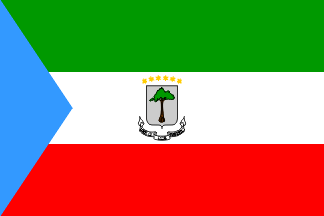
![[National flag and ensign]](../misc/oooooo.gif) 2:3~
Image by Željko Heimer, 23 Oct 2001
2:3~
Image by Željko Heimer, 23 Oct 2001Flag adopted on 21 August 1979 and Coat of Arms adopted on 21 August 1979.

Last modified: 2015-03-07 by bruce berry
Keywords: equatorial guinea | guinea ecuatorial | silk | unitad | pax | justicia |
Links: FOTW homepage |
search |
disclaimer and copyright |
write us |
mirrors

![[National flag and ensign]](../misc/oooooo.gif) 2:3~
Image by Željko Heimer, 23 Oct 2001
2:3~
Image by Željko Heimer, 23 Oct 2001
Flag adopted on 21 August 1979 and Coat of
Arms adopted on 21 August 1979.
See also:
The flag of Equatorial Guinea is a horizontal tricolor of green over white over red, with a blue triangle at the hoist. The coat of arms are to be found in the centre of the white stripe. The arms are gray with silk cotton tree. Above are six yellow six pointed stars representing the mainland and islands which make up the country. Under shield is a motto: UNIDAD - PAZ - JUSTICIA (Unity, Peace, Justice). The flag was adopted at independence on 12 October 1968. During the dictatorship of Francisco Nguema (1972-79) the emblem on flag was changed, but the original 1968 coat of arms was restored after Nguema was deposed in August 1979.
The symbolism of the colours is as follows:
Green symbolises the natural resources and the flora and fauna of the country;
Blue symbolises the sea, which connects the mainland with the islands, which together form the country;
White symbolises peace; and
Red symbolises the struggle for independence.
Željko Heimer 14 Dec 1995
The construction details of the flag are given in Album des pavillons nationaux et des marques distinctives (National flags and distinctive markings) 2000 edition [pay00] as (2+2+2):9~ but I think this merely notes that the three stripes are of the same width and that:
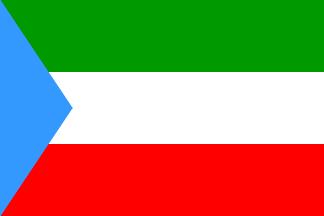
![[Civil flag and ensign]](../misc/oxxoxx.gif)
![[Variant]](../misc/fis_vari.gif) 2:3~
Image by Željko Heimer, 23 Oct 2001
2:3~
Image by Željko Heimer, 23 Oct 2001
Album [pay00] gives the flag without the coat of arms as
being the "Unofficial Variant" for a civil flag and ensign.
Željko Heimer, 23 Oct 2001
The protocol manual for the London 2012 Olympics
(Flags and Anthems Manual, London, 2012 [loc12])
provides recommendations for national flag designs. Each National Olympic
Committee was sent an image of their flag, including the PMS shades, by the
London Organising Committee of the Olympic Games (LOCOG) for their approval.
Once this was obtained, the LOCOG produced a 60 x 90 cm version of the flag for
further approval. So, while these specifications may not be the official,
government, version of each flag, they are certainly what the National Olympic
Committee believed their flag to be.
For Equatorial Guinea : PMS 355 green, 293 blue, 032 red, 468 brown, 440 brown,
109 yellow and black. The vertical flag is simply the horizontal version turned
90 degrees clockwise.
Ian Sumner,
10 Oct 2012
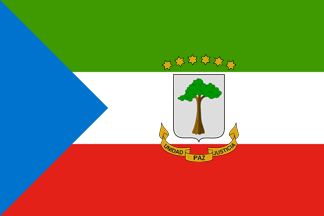 image by George Lei Ren, 20 Feb 2015
image by George Lei Ren, 20 Feb 2015
I recently got a book in Chinese called
'Geguo Gaikuang' (or World Factbook) published in 1972 and found the
Equatorial Guinean flag in that book different from that illustrated or
described in any other source as illustrated above.
The flag is similar to the official version, but with the blue part being a
right angle triangle and the coat of arms touches parts of the green and red
stripes and is not just confined to the white strip.
I've no idea if or when this flag was in use, but considering the year of
publishing of that book, I'm presuming it was between 1969 and 1973. Can
anyone shed some
George Lei Ren, 20 Feb 2015
As far as I can discover there are no
official specifications for Equatorial Guinea, and the many flag book
illustrations I have seen mostly differ as to the length of the triangle and the
position of the arms. My own specification was based
upon an unsatisfactory official illustration and it places the triangle at
one-third the flag’s length and centres the arms between the point of the
triangle and the fly. However, the main image on this page (based upon
Album des Pavillons) shows the arms centred on the flag and the triangle at
one-third the width. It would appear that until official specifications
are published, such variations will continue to be produced.
Christopher Southworth, 20 Feb 2015
The early history of the flag of
Equatorial Guinea is vague. It was only on 08 October 1968, four days away from
independence on 12 October 1968, that its parliament agreed on the design of the
national flag. Newspaper clippings from those days mention the description
of the flag without the coat of arms. It looks like there was not much time to
mass produce the flag design adopted by parliament and so many variants
appeared. A photograph published in the Het Vrije Volk newspaper in
Rotterdam shows people holding and waving paper flags with three plain
horizontal stripes. There is no triangle or arms on the flag.
Jos Poels, 21 Feb 2015
The flags which were used officially
during the Independence celebrations of Equatorial Guinea in Santa Isabel (now
Malabo), do not have a coat of arms as seen
here in a photo taken on the Plaza de España.
In the October-November 1968 issue of the magazine La Guinea Ecuatorial
is a photo of
the government building in Santa Isabel on independence day (12 October 1968).
It clearly shows a flag flying without the coat of arms.
Jos Poels, 23 Feb 2015
.gif) Image by Željko Heimer, 23 Oct 2001
Image by Željko Heimer, 23 Oct 2001
The coat of arms of Equatorial Guinea were adopted on 21 August 1979 and feature a silk cotton tree (the so called "God Tree") on a gray background. The tree is where the first treaty was signed between Spain and a local ruler signifying the beginning of the colonial period. Above the shield are six yellow six-pointed stars representing mainland and the five main islands which together comprises the country. Under shield is the national motto: UNIDAD - PAZ - JUSTICIA (Unity, Peace, Justice). The Arms were originally at independence but were changed during the dictatorship of Francisco Nguema (1972-79) and were restored in 1979.
The coat of arms are found in the centre of the white stripe of the national flag.
The coat of arms in the above image is adapted from Corel Clipart collection.
Željko Heimer, 14 Dec1995
According to the
website of the Government of Equatorial Guinea, the arms are based on the
arms granted by the King of Spain to the town of Bata, now the largest town in
the country The shield portrays a "capoquero" (kapok) tree
surmounted by six stars representing the six components of the country, Fernando
Poo, Río Muni (the continental component of the country), Elobey Grande, Elobey
Chico, Corisco and Annobón. The kapok was nicknamed the "Tree of the Gods"
in the 19th century as the Bonkoro swore loyalty to the King of Spain under such
a tree.
Kapok (Ceiba pentandra (L.) Gaertn.) Family Malvaceae, is a tree native
from Mexico, Central America and the Caribbean, and West
Africa as well. The tree is widely cultivated in southeast Asia (where it
is known as Java kapok) for fibre. Venerated as a sacred tree by the
Mayas, Kapok is the national tree of Guatemala and
Puerto Rico.
Ivan Sache, 10 Oct 2010
There is currently no Presidential standard in Equatorial Guinea.
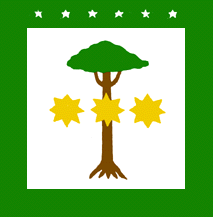
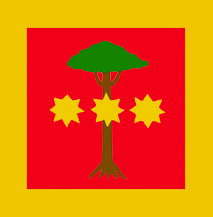
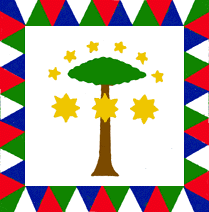 Images by Jaume Ollé, 01 July 1997
Images by Jaume Ollé, 01 July 1997
However, in 1986 the Presidency of the Equatorial Guinea requested the design for a presidential standard. Tomas Rodriguez and Antonio Manzano make three proposals that were presented to the then President, Teorodo Obiang Nguema Mbasogo.
The proposals all featured the silk cotton tree (Ceiba
in Spanish) from the national Arms with three yellow "colonel" stars to signify
the rank of President Obiang in the army (in the Spanish army I suppose, since he obtained his title in Spain). The six stars are not explained, but they
could correspond to the country's districts or the pieces of territory which
together make up the country.
Source: Moharra number 2, September 1986.
Jaume Ollé, 01 July 1997
A list of Equatorial Guinea's seven provinces is given on the Spanish language Wikipedia, with a link to each province which shows an illustration of each provincial flag.
I believe these must be fictional flags. This version of Wikipedia is one of the worse to depict the glorification of the former Spanish Empire. Despite Equatorial Guinea having one of the highest costs of living, I doubt that each province has its own flag.
Several of the illustrated provincial flags seem to be inspired by those of Espiritu Santo (Brasil), South Africa (before 1994) and Shanland.
Any photographic
confirmation of these flags will be welcome.
Jaume Ollé, 11 Oct 2013